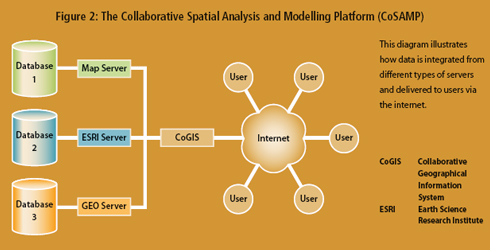Towards Global Information Management in Long-Term Ecological Research
Editorial by Avinash Chuntharpursat, Information Management Coordinator, SAEON
A SAEON delegation recently made a trip to Namibia for a very special reason – to attend the Environmental Long-term Observatories of Southern Africa (ELTOSA) Regional Workshop on 13 August 2006, and the Annual General Meeting of the International Long-Term Ecological Research (ILTER) network from 14 to 18 August.
The delegation - which consisted of SAEON Head Johan Pauw, SAEON’s recently appointed Observation Science Specialist, Tim O’Connor, SAEON’s Information Management Coordinator Avinash Chuntharpursat, and Wandile Nomquphu, Department of Water Affairs and Forestry member on the SAEON Technical Steering Committee - took an active part in the information management (IM) session conducted during the ILTER workshop. The presentation on the SAEON Information Management System, including the Collaborative GIS (CoGIS), was well received.
As part of the ILTER activities, several committees were formed, one of which was the Information Management Committee. Kristin Vanderbilt of the US-LTER was elected as Chair of the IM Committee, with Avinash as Vice-Chair and Cristiana Cocciufa of LTER-Italy as Secretary.

One of the tasks of the IMC is to develop a globally relevant IM system for ILTER data to form the backbone of joint research programmes and data sharing in ILTER. During the course of the ILTER meeting it emerged that there were three different but globally relevant systems:
- The Ecological Metadata Language (EML) system, developed largely by the United States and actively implemented in Taiwan and China
- An ontologies-based system currently being developed in Europe as part of Alter-Net activities (the ontologies for this system have been under development for the past 10 years)
- A collaborative GIS and modelling system currently being developed in South Africa, which focuses on spatial data
Each of the three systems has its own strengths and weaknesses. An initial assessment revealed that the systems could complement each other, which could lead to a global IM system that is an assimilation of all three.
The potential in this has led to another ILTER-IMC meeting being planned for 18 -19 September 2006 in Colorado, USA. This was due to the convenience of having the US-ILTER IM Workshop and the All Scientist Meeting taking place at the same venue during the same week.
Avinash, partly sponsored by the USLTER, participated in these meetings and will report back on the ensuing developments in the next issue of SAEON eNews.










